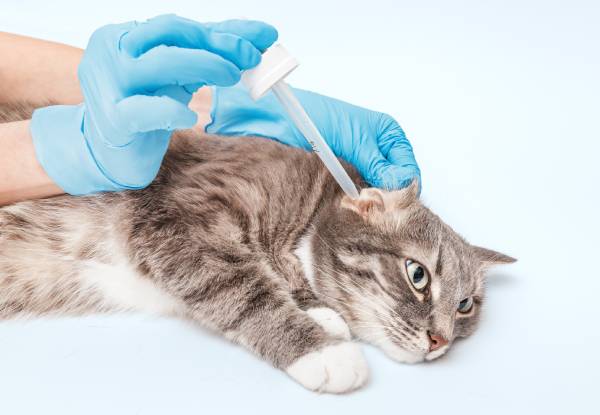Mites (Demodex & Scabies) Treatment
Mite infestations are a common cause of itching, hair loss, and skin infections in pets. Among the various types of mites, Demodex and Scabies (Sarcoptic mange) mites are the most frequently encountered and can lead to significant discomfort if left untreated. Veterinary dermatologists specialize in diagnosing and treating these parasitic skin conditions with targeted therapies that restore your pet’s skin health and comfort.

What Are Demodex Mites?
Demodex mites are tiny parasites that live in or near hair follicles. All dogs and cats naturally carry small numbers of Demodex mites, which usually coexist harmlessly with the host’s immune system. Problems arise when these mites multiply uncontrollably, leading to a condition called demodicosis or demodectic mange.
There are different species of Demodex mites, with Demodex canis affecting dogs and Demodex cati and Demodex gatoi affecting cats. The disease often causes:
- Hair loss (alopecia)
- Redness and scaling of the skin
- Secondary bacterial infections
- Itching, though sometimes mild compared to other mite infestations
Demodicosis commonly affects puppies or immunocompromised adult animals but can occur in healthy adults as well.
What Is Scabies (Sarcoptic Mange)?
Scabies, caused by the mite Sarcoptes scabiei, is a highly contagious skin disease affecting dogs (rare in cats). These mites burrow into the upper layers of the skin, causing intense itching, redness, and inflammation.
Symptoms of scabies include:
- Severe itching, often worsening at night
- Hair loss and crusting, especially around the ears, elbows, and abdomen
- Thickened, scaly skin in chronic cases
Because Sarcoptes mites are contagious to other animals and humans, prompt diagnosis and treatment are essential.

How Are Mite Infestations Diagnosed?
Diagnosing mite infestations requires careful examination by a veterinary dermatologist. Common diagnostic methods include:
- Skin Scrapings: Deep skin scrapings are examined under a microscope to detect mites, their eggs, or feces.
- Tape Tests or Hair Plucks: Sometimes used to collect mites from the skin surface.
- Response to Treatment: In some cases, a positive response to therapy helps confirm the diagnosis, especially if mites are difficult to find.
Because mite infestations can mimic other skin conditions such as allergies or fungal infections, expert diagnosis is critical for effective treatment.
Treatment Options for Demodex and Scabies
Demodex Treatment
Treatment for demodicosis varies depending on the severity and extent of the infestation:
- Localized Demodex: Mild cases with small patches of hair loss may resolve spontaneously or respond well to topical treatments prescribed by a veterinary dermatologist.
- Generalized Demodex: Widespread or severe infestations require prolonged treatment, often involving medicated dips, oral medications (such as ivermectin or newer isoxazolines like fluralaner), and management of secondary infections.
Consistent treatment and follow-up are necessary to monitor progress and prevent relapse.
Scabies Treatment
Scabies requires aggressive and prompt treatment due to its contagious nature:
- Medicated Baths or Dips: Special shampoos and dips help eliminate mites on the skin surface.
- Oral or Injectable Medications: Ivermectin, selamectin, or newer drugs such as fluralaner are used to kill mites systemically.
- Environmental Control: Because scabies mites can survive off the host briefly, cleaning bedding and living areas helps prevent reinfestation.
Both Demodex and scabies treatment plans often include antibiotics or antifungals to manage secondary skin infections.
Why Choose a Veterinary Dermatologist for Mite Treatment?
Veterinary dermatologists bring specialized expertise to diagnose and treat mite infestations effectively. Their knowledge ensures:
- Accurate diagnosis differentiating mites from other skin diseases
- Appropriate selection of treatment based on mite type and severity
- Management of secondary infections and complications
- Long-term follow-up to prevent recurrence
Early intervention by a specialist helps your pet recover quickly and reduces the risk of spreading contagious mites.
Preventing Mite Infestations
While not all mite infestations are preventable, good pet care can reduce risk:
- Maintain regular veterinary checkups
- Use flea and parasite preventatives as recommended
- Avoid contact with infected animals, especially in kennels or shelters
- Keep your pet’s living environment clean
Prompt attention to any signs of itching or hair loss can prevent minor issues from becoming severe infestations.
Frequently Asked Questions (FAQs)
Are mite infestations contagious to humans?
Sarcoptic mange (scabies) mites can temporarily infest humans, causing itching and rash, but they do not complete their life cycle on people. Demodex mites are species-specific and not contagious to humans.
How long does treatment for mites take?
Treatment duration varies. Localized demodex may resolve in weeks, while generalized demodicosis and scabies often require several weeks to months of therapy.
Can mites come back after treatment?
Recurrence is possible, especially if the underlying immune system is compromised. Regular monitoring is important.
Are there side effects to mite treatments?
Most treatments are safe when used as directed. Some pets may experience mild side effects, which your veterinary dermatologist will discuss with you.
Can cats get scabies?
True scabies (Sarcoptes scabiei) is rare in cats. However, cats can have other mite infestations such as Notoedres cati which cause similar symptoms.
Conclusion
Mite infestations like Demodex and scabies cause significant discomfort and skin problems in pets but can be effectively diagnosed and treated by veterinary dermatologists. Early intervention, accurate diagnosis, and tailored treatment plans are key to restoring your pet’s skin health and comfort.
If your pet is scratching excessively, losing hair, or developing skin sores, consult a veterinary dermatologist promptly to rule out mites and begin appropriate treatment. With expert care, most pets recover fully and return to a happy, itch-free life.


